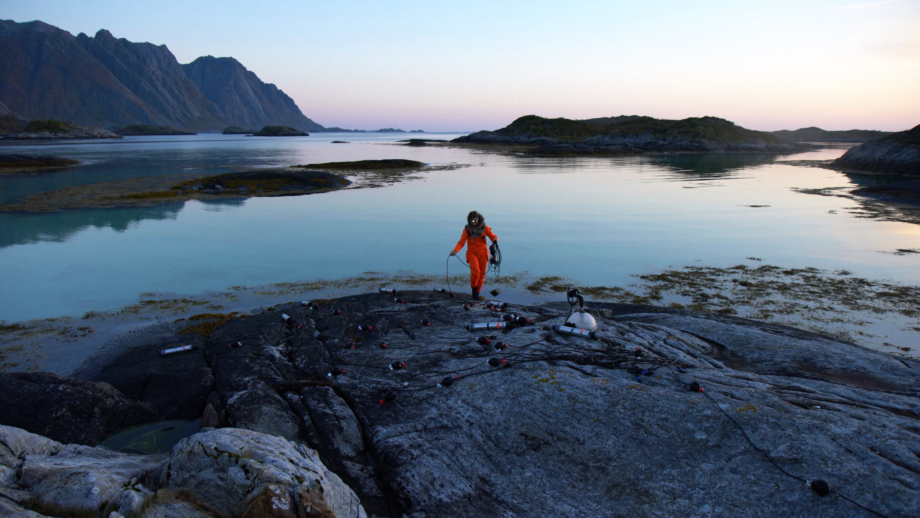online / Bio-diversity – Acoustic Ocean
Date and time
24. 4. 2021 – 30. 4. 2021
on-line
Bio-diversity is the curated program within the Bio Troja project, where we will for certain period point to selected audiovisual works related to the context of art and ecology. These videos are published with the consent of authors and provided with an accompanying text introduction. The first chapter of four pieces was curated by Miloš Vojtěchovský.
Please view with headphones, as Acoustic Ocean is also a sound piece.
Swiss artist Ursula Biemann captured the airy Arctic landscape on the rocky coast of the Lofoten Islands in northern Norway through the prism of image and sound ecology. The only character in this short feature documentary is a slender female explorer in an orange diver suit. She symbolizes the current feminist concept of the necessity of returning to the entangled world of man and planetary ecosystems, in this case monitored by sophisticated and non-invasive listening techniques.
We are following the Sami singer and performer Sofia Jannok performing the role of a marine biologist who works equipped with a system of sensors – hydrophones, an ornithologist dish and digital devices – to engage in a dialogue with the invisible creatures living below and above the ocean, listening to the sounds being emitted in her headphones. The video soundtrack is extended with audio files from the archive of underwater recordings of ichthyologist Rodney Rountree and the oceanographic collection of the Discovery of Sound in the Sea Institute at the University of Rhode Island.
The volume level of the Arctic sonic environment is influenced by various factors: wind speed and streaming of water, cracking and melting of glaciers, i.e. geophony and rich and mysterious biophony – the sounds arising from the migration and communication of marine fauna. The third factor is Anthropophony – noise accompanying human activities both on land and in the ocean. The latter factor can be considered as the main frame of this video piece: due to the low visibility in the deep cold ocean, sound is the most important medium for animals to communicate and navigate through. Good audibility is essential and more important to the life of most deep-sea animals than sight. The noise as a symptom of the evolving human colonization and exploitation of the planet – apart from the higher temperatures, rising acidity and pollution by microplastics – is one of the core reasons for the ongoing extinction of many species of marine life.
In the titles, the artist quotes several sources she was inspired by during the production of the work: the books Bodies of Water by Australian environmentalist Astrida Neimanis, Staying with the Trouble: Making Kin in the Chthulucene by anthropologist/philosopher Donna J. Haraway, or Alien Ocean: Anthropological Voyages in Microbial Seas by the anthropologist Stefan Helmreich. In one of the mentioned books, Haraway claims we should accept the feelings of solidarity with the injured planet. Instead of the term “Age of People” – Anthropocene, she proposes a somehow more fitting term Capitalocene and considers the third epoch – Chthulucene, where the human and non-human would be reconnected and when we will have to accept the critical condition of a damaged planet. Haraway proposes to hasten the end of the Capitalocene by changing our perceptual modes: learning other languages, so we would understand the other species we used to hunt, and – if we survive – make kinship “with those we would prefer to eschew, with those who are not like us, acting together in unexpected collaborations and combinations”.
The ethical and aesthetic mission of the video(installation) Acoustic Ocean is to strive for a radical transformation of human relationship towards the space we are cohabitating with species that used to live for millennia symbiotically. It may be a symbolic gesture, but in the titles, next to the authors’ names, the names of the sea creatures whose voices were heard are mentioned as well: Greenland whale, humpback whale, giant flounder, dolphin, sea trout, shrimp, and more. It is a symbolic expression of the artist’s call for sovereignty of submarine creatures which, due to our predatory technology and our barbaric way of thinking, have been pushed by our culture to the very brink of extinction over, at least since the last two hundred years.
Acoustic Ocean has been commissioned by the Atlantic Project After the Future – in the wake of utopian imaginaries in Plymouth (UK) curated by Tom Trevor.
Crew: Set designer Michael Graessner (Berlin) has designed the props for the marine scientist. Sofia Jannok, singer, musician and climate activist from the Sami Northern Scandinavian indigenous community is doing the performance and Lydia Zimmermann the camera (Barcelona/Zurich). Patrick Codenys (Brussels) is the sound designer.
The project has been supported by a generous grant of Pro Helvetia Swiss Council for the Arts. In 2020, Acoustic Ocean was exhibited at transmediale Berlin, HKW; Centre Culturel Suisse Paris, MAMAC Nice, Bienal of the Moving Image, Buenos Aires.
Acoustic Ocean was premiered in Eco-Visionaires at the House of Electronic Arts in Basel and was exhibited in Zeitspuren – The Power of Now, Pasquart, Biel in Propositions, Helmhaus Zurich; in After the Future – in the wake of utopian imaginaries, Plymouth, Between Bodies at Henry Art Gallery der University of Washington in Seattle, Post-Nature: An Exhibition as an Ecosystem, the Biennale in Taipei at the Centre Culturel Suisse Paris, and in the solo show Indigenous Knowledge_Cosmological Fictions at MAMAC in Nice.
CCS Paris and MAMAC Nice produced together a beautiful publication in French and English with a text by Yvonne Volkart “Forming a Future Organe”.
More information: geobodies.org/art-and-videos/acoustic-ocean
New monograph Becoming Earth: http://becomingearth.unal.edu.co/ includes a discussion about the work as well.


